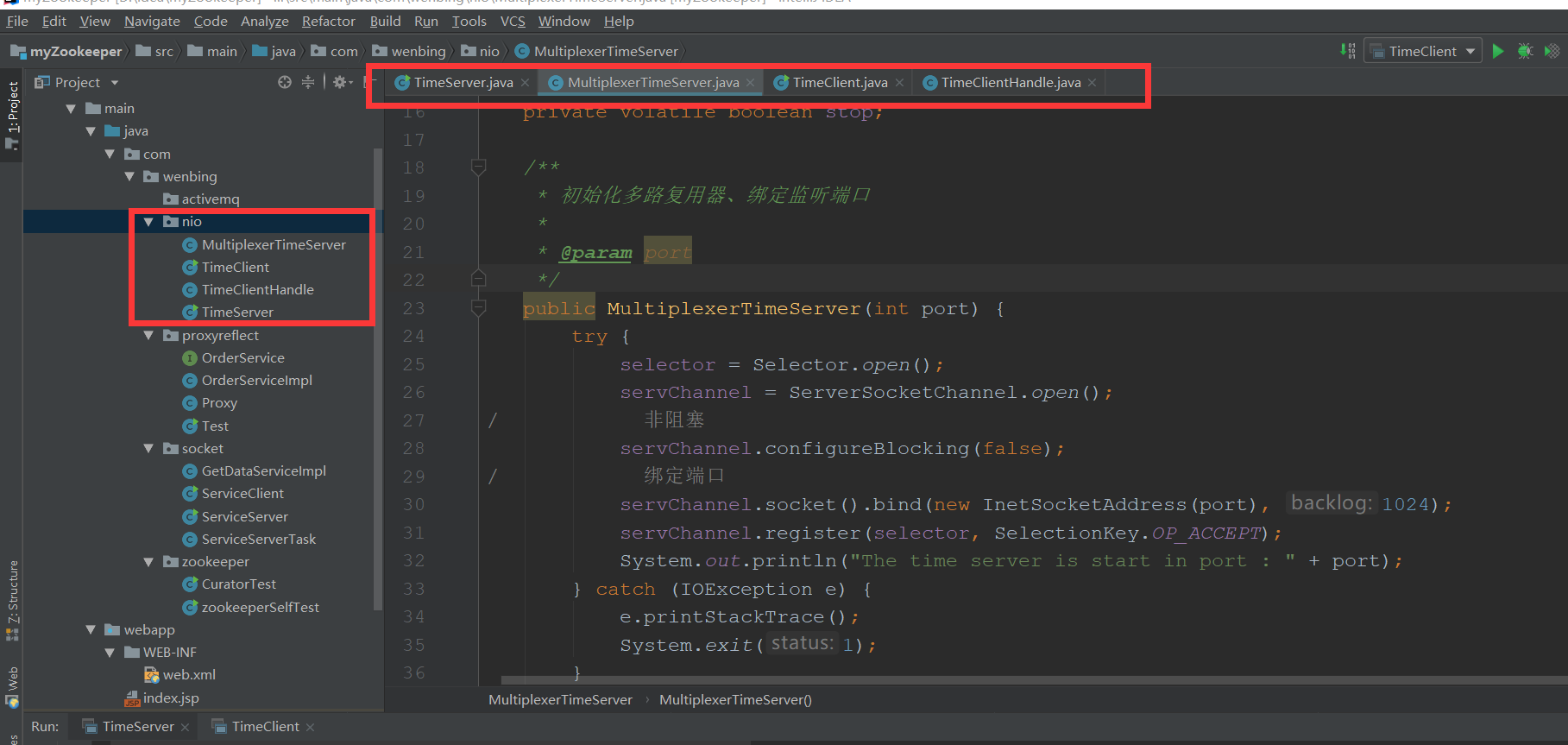https://www.cnblogs.com/wenbinshen/p/9902814.html
我正在为学习大数据打基础中,为了手撸rpc框架,需要懂得nio的原理,在搞懂nio框架前,我会带着大家手撸一些比较底层的代码,当然今后当我们学会了框架,这些繁琐的代码也就不用写了,但是学一学底层的代码也是有好处的嘛。
java.nio全称java non-blocking IO(实际上是 new io),是指jdk1.4 及以上版本里提供的新api(New IO) ,为所有的原始类型(boolean类型除外)提供缓存支持的数据容器,使用它可以提供非阻塞式的高伸缩性网络。
前面我写的socket的服务端与客户端的通信是线程阻塞的,这在实际应用场景中并不竟如人意,我们更多需要的是异步操作,用户无感知,当我们在操作主线程的时候,一些通信相关的线程不应该阻塞我们的主线程。我们需要传送数据,我们只要将请求发送出去,这时候具体的发送细节就应该交由底层的操作系统帮我们完成,我们应该可以操作主线程继续完成其他事情。nio就为我们解决这些事情提供了很好的办法。
学会nio之前我们需要了解这几个概念:
Channel:
Channel是一个对象,可以通过它读取和写入数据。拿 NIO 与原来的 I/O 做个比较,通道就像是流,而且他们面向缓冲区的。
所有数据都通过 Buffer 对象来处理。您永远不会将字节直接写入通道中,相反,您是将数据写入包含一个或者多个字节的缓冲区。同样,您不会直接从通道中读取字节,而是将数据从通道读入缓冲区,再从缓冲区获取这个字节。
通道与流的不同之处在于通道是双向的。而流只是在一个方向上移动(一个流必须是 InputStream 或者 OutputStream 的子类), 而 通道 可以用于读、写或者同时用于读写。
因为它们是双向的,所以通道可以比流更好地反映底层操作系统的真实情况。特别是在 UNIX 模型中,底层操作系统通道是双向的。
缓冲区:
是一个固定数据量的指定基本类型的数据容器。除内容之外,缓冲区还具有位置 和界限,其中位置是要读写的下一个元素的索引,界限是第一个应该读写的元素的索引。基本 Buffer 类定义了这些属性以及清除、反转 和重绕 方法,用以标记 当前位置,以及将当前位置重置 为前一个标记处。
每个非布尔基本类型都有一个缓冲区类。每个类定义了一系列用于将数据移出或移入缓冲区的 get 和 put 方法,用于压缩、复制 和切片 缓冲区的方法,以及用于分的异类或同类二进制数据序列),访问要么是以 big-endian字节顺序进行,要么是以 little-endian 字节顺序进行。
判断:
由于客户端断开连接时,服务器端SocketChannel不会立即自动改变连接状态,其仍然可以read()。所以通常以read()返回值进行判断。当read()返回为-1时即判断该连接断开。即当channel读到末尾后仍然没有数据发送,服务器即断开连接。
我们示例的基本架构如下:

先定义一个TimeServer
package com.wenbing.nio;
public class TimeServer {
public static void main(String[] args) {
int port = 8085;
if (args != null && args.length < 0) {
port = Integer.valueOf(args[0]);
}
MultiplexerTimeServer timeServer = new MultiplexerTimeServer(port);
new Thread(timeServer,"NIO-MultiplexerTimeServer-001").start();
}
}
再定义一个MultiplexerTimeServer去实现Runnable接口,每个通信的操作交由这一个线程去完成。
package com.wenbing.nio;
import java.io.IOException;
import java.net.InetSocketAddress;
import java.nio.ByteBuffer;
import java.nio.channels.*;
import java.util.Iterator;
import java.util.Set;
public class MultiplexerTimeServer implements Runnable {
private Selector selector;
private ServerSocketChannel servChannel;
private volatile boolean stop;
/**
* 初始化多路复用器、绑定监听端口
*
* @param port
*/
public MultiplexerTimeServer(int port) {
try {
selector = Selector.open();
servChannel = ServerSocketChannel.open();
// 非阻塞
servChannel.configureBlocking(false);
// 绑定端口
servChannel.socket().bind(new InetSocketAddress(port), 1024);
servChannel.register(selector, SelectionKey.OP_ACCEPT);
System.out.println("The time server is start in port : " + port);
} catch (IOException e) {
e.printStackTrace();
System.exit(1);
}
}
public void stop() {
this.stop = true;
}
@Override
public void run() {
while (!stop) {
try {
selector.select(1000);
// 查询存在的活跃的key
Set<SelectionKey> selectedKeys = selector.selectedKeys();
// 迭代所有活跃的key,进行操作
Iterator<SelectionKey> it = selectedKeys.iterator();
SelectionKey key = null;
while (it.hasNext()) {
key = it.next();
// 拿到某个key后,就将其从迭代器里除去
it.remove();
try {
handleInput(key);
} catch (Exception e) {
if (key != null) {
key.cancel();
if (key.channel() != null) {
key.channel().close();
}
}
}
}
} catch (Throwable t) {
t.printStackTrace();
}
}
// 多路复用器关闭后,所有注册在上面的Channel和Pipe等资源都会被自动去注册并关闭,所以不需要单个关闭
if (selector != null) {
try {
selector.close();
} catch (IOException e) {
e.printStackTrace();
}
}
}
private void handleInput(SelectionKey key) throws IOException {
if (key.isValid()) {
// 处理新接入的请求消息
if (key.isAcceptable()) {
// Accept the new connection
ServerSocketChannel ssc = (ServerSocketChannel) key.channel();
SocketChannel sc = ssc.accept();
sc.configureBlocking(false);
// Add the new connection to the selector
sc.register(selector, SelectionKey.OP_READ);
}
if (key.isReadable()) {
// Read the data
SocketChannel sc = (SocketChannel) key.channel();
ByteBuffer readBuffer = ByteBuffer.allocate(1024);
int readBytes = sc.read(readBuffer);
if (readBytes > 0) {
readBuffer.flip();
byte[] bytes = new byte[readBuffer.remaining()];
readBuffer.get(bytes);
String body = new String(bytes, "UTF-8");
System.out.println("The time server receive order : " + body);
//将当前时间发回去
String currentTime = "QUERY TIME ORDER"
.equalsIgnoreCase(body) ? new java.util.Date(
System.currentTimeMillis()).toString() : "BAD ORDER";
doWrite(sc, currentTime);
} else if (readBytes < 0) {
// 对端链路关闭
key.cancel();
sc.close();
} else
; //读到0字节,忽略
}
}
}
private void doWrite(SocketChannel channel, String response) throws IOException{
if (response != null && response.trim().length() > 0) {
byte[] bytes = response.getBytes();
ByteBuffer writeBuffer = ByteBuffer.allocate(bytes.length);
writeBuffer.put(bytes);
writeBuffer.flip();
channel.write(writeBuffer);
}
}
}
定义TimeClient
package com.wenbing.nio;
public class TimeClient {
/**
*
* @param args
*/
public static void main(String[] args) {
int port = 8085;
if (args != null && args.length > 0) {
try {
port = Integer.valueOf(args[0]);
} catch (NumberFormatException e) {
//采用默认值
}
}
new Thread(new TimeClientHandle("127.0.0.1", port), "TimeClient-001").start();
}
}
定义TimeClientHandle同样继承Runnable接口,与上面的MultiplexerTimeServer作用类似。
package com.wenbing.nio;
import java.io.IOException;
import java.net.InetSocketAddress;
import java.nio.ByteBuffer;
import java.nio.channels.SelectionKey;
import java.nio.channels.Selector;
import java.nio.channels.SocketChannel;
import java.util.Iterator;
import java.util.Set;
public class TimeClientHandle implements Runnable {
private String host;
private int port;
private Selector selector;
private SocketChannel socketChannel;
private volatile boolean stop;
public TimeClientHandle(String host, int port) {
this.host = host == null ? "127.0.0.1" : host;
this.port = port;
try {
selector = Selector.open();
socketChannel = SocketChannel.open();
socketChannel.configureBlocking(false);
} catch (IOException e) {
e.printStackTrace();
System.exit(1);
}
}
@Override
public void run() {
try {
doConnect();
} catch (IOException e) {
e.printStackTrace();
System.exit(1);
}
while (!stop) {
try {
selector.select(1000);
Set<SelectionKey> selectedKeys = selector.selectedKeys();
Iterator<SelectionKey> it = selectedKeys.iterator();
SelectionKey key = null;
while (it.hasNext()) {
key = it.next();
it.remove();
try {
handleInput(key);
} catch (Exception e) {
if (key != null) {
key.cancel();
if (key.channel() != null) {
key.channel().close();
}
}
}
}
} catch (IOException e) {
e.printStackTrace();
System.exit(1);
}
}
}
private void doConnect() throws IOException {
//如果直接连接成功,则注册到多路复用器上,发送请求消息,读应答
if (socketChannel.connect(new InetSocketAddress(host, port))) {
socketChannel.register(selector, SelectionKey.OP_READ);
doWriter(socketChannel);
} else {
socketChannel.register(selector, SelectionKey.OP_CONNECT);
}
}
private void doWriter(SocketChannel sc) throws IOException {
byte[] req = "QUERY TIME ORDER".getBytes();
ByteBuffer writeBuffer = ByteBuffer.allocate(1024);
writeBuffer.put(req);
writeBuffer.flip();
sc.write(writeBuffer);
if (!writeBuffer.hasRemaining()) {
System.out.println("Send order 2 server succeed.");
}
}
private void handleInput(SelectionKey key) throws IOException {
if (key.isValid()) {
// 判断连接是否成功
SocketChannel sc = (SocketChannel) key.channel();
if (key.isConnectable()) {
if (sc.finishConnect()) {
sc.register(selector, SelectionKey.OP_READ);
doWriter(sc);
} else {
System.exit(1);//连接失败,进程退出
}
}
if (key.isReadable()) {
ByteBuffer readBuffer = ByteBuffer.allocate(1024);
int readBytes = sc.read(readBuffer);
if (readBytes > 0) {
readBuffer.flip();
byte[] bytes = new byte[readBuffer.remaining()];
readBuffer.get(bytes);
String body = new String(bytes, "UTF-8");
System.out.println("Now is : " + body);
this.stop = true;
} else if (readBytes < 0) {
//对端链路关闭
key.cancel();
sc.close();
} else
;//读到0字节,忽略
}
}
}
}
启动TimeServer和TimeClient的main方法,运行结果如下:
TimeServer控制台打印如下:
The time server is start in port : 8085
The time server receive order : QUERY TIME ORDER
The time server receive order : QUERY TIME ORDER
TimeClient控制台打印如下:
Send order 2 server succeed.
Now is : Sun Nov 04 00:10:56 CST 2018
Now is : Sun Nov 04 00:10:56 CST 2018
纸上得来终觉浅,绝知此事要躬行,快去动手自己撸一撸吧。
